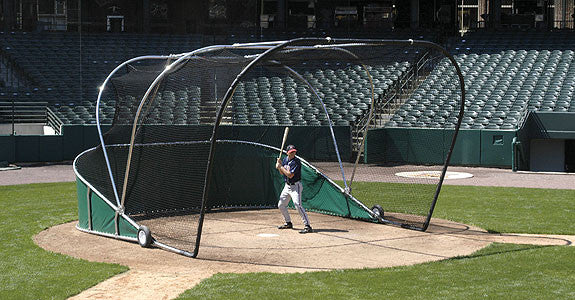Hitting (Hitting off a Tee)
Favorite part of practice is batting practice, where they get to see how hard and far they can hit a baseball. The problem with batting practice is how kids handle it. A lot of kids see batting practice as a homerun derby with the ball perfectly placed each time (or waiting for a perfectly placed one) and swinging for the fences. When you hit off a Tee, your goals can be made more appropriate for trying to become a better hitter and can be made more realistic to game situations when done correctly. The goal of hitting the ball off the tee is to try and square up the ball as much as possible because almost all results will be the same anyways. Hitting off a tee allows you to forget about your surroundings and concentrating on increasing your strength and using proper technique. Placing the Tee in different locations that represent where an actual ball may be pitched to you - raise and lower the Tee, place it closer to you and further away - can help you learn what adjustments your body will need to make to square up on a ball based on the pitch location.
Ground balls (Using a Wall)
Taking ground balls seems like it would be at least a two person activity but it doesn’t need to be. If you’re in a position where you can only practice by yourself, try throwing yourself groundballs off the wall (among other ideas). You don’t need to have a hard ball to practice this. If you have any type of ball that bounces you can work on almost all the skills involved with picking up a ground ball. You can still learn to read different types of hops while regulating your speed to the ball allowing your body to be in a good fielding position. The best part of throwing a ball off the wall is you can adjust every throw to cater to your defensive needs. The only thing you can’t really simulate is being able to read a ball off the bat, but learning how to get your body in a good fielding position will ultimately help you with that as well.
Pop ups (Using a Tennis Racket)
This is a little easier with a partner, but catching pop ups generally requires a coach that’s capable of hitting pop flies to their target and this can be very difficult for inexperienced coaches and an inefficient use of time. It can make pop ups a lot easier if you try it with a tennis ball and racket. Using a tennis racket and hitting the ball up in the air is a great way to consistently hit pop ups at your target. Along with being able to hit them extremely high and accurate, the tennis ball will be influenced by the wind making it a challenge for the person receiving them. This drill works great for catchers pop ups.
All of these drills will help you practice your skills on your own and are just a few examples of many ways you can work on your own. When trying to become a better athlete, all of your most important work will get done on your own so don't wait for a team practice or a bunch of teammates to get together. Try and find different ways that you can become great at practicing baseball without relying on anyone else.
I'd love to hear about your favorite "solo" drills. Please feel free to share them in the comments below so others can benefit from them.
Kevin Hussey
JIM R0NAI
DIRECTOR OF PHYSICAL THERAPY AND SPORTS MEDICINE AT REHABILITATION ASSOCIATES, INC., STRATFORD, CT
Although baseball is not traditionally considered as a high impact or collision sport, many players between the ages of 10 and 18 who participate in baseball suffer from some degree of musculotendinous contusion, strain or ligamentous sprain.
In organized situations, the majority of these injuries are initially managed utilizing appropriate basic first aid strategies. These include a primary assessment, immobilization of the injured body part, the application of compression to the injured area, elevation of the injured body part when applicable and finally the application of ice.
Many strains, contusions and sprains sustained in baseball are not severe enough to require long term management of a physician or medical professional.
After an initial first aid evaluation, most soft tissue injuries are managed conservatively without further professional medical advice. In these instances, parents, coaches and athletes are left to progress activities and implement the use of thermal agents (ice and heat) as important adjuncts to the healing and recovery process.
During this process, questions and concerns regarding the proper parameters for the use of ice and heat and the transition from one to the other often arise. It is essential that the decision-makers understand the proper use of ice and heat and the effects, both positive and negative, associated with them.
The use of cryotherapy (ice related products) in the management of acute ligament sprains, muscle and tendon sprains and contusions, is a widely accepted method of treatment by sports medicine professionals.
Although most individuals perceive ice and associated cooling agents as uncomfortable, they have been proven effective in decreasing swelling and spasming associated with musculoskeletal injuries.
Pain reduction as a result of the application of ice or other tissue temperature reducing agents often allows the initiation and return of early joint range of motion. Early, normal joint motion patterns promote the realignment and repair of damaged tissues at the cellular level.
The consensus among sports medicine professionals is that ice is most effective when it is applied to injured tissue two to three times per hour during the first 48 to 72 hours following an injury in 12 to 20 minute increments starting as immediately close to the time of injury as possible.
This initial two to three day period or acute phase of the injury is the most critical time when the application of a cooling agent can limit harmful effects of the immune related inflammatory response to injury. This creates a positive impact on an athlete’s overall recovery while decreasing time away from play. Conversely, the application of a heating agent during the 48 to 72 hour acute phase of injury can serve as an irritant and exacerbate a resolving condition.
To avoid the risk of damage to superficial tissues or in stances where an individual is extremely sensitive to cold, use of a thin cotton barrier between skin and ice should be considered. It is also important to take extra precautions when applying in proximity to the ulna nerve, which is located in the medial elbow, and the peroneal nerve located in the lateral aspect of the knee. In both instances, the time of ice application should be closely monitored and the use of an ice barrier is advised.
The range of varieties and prices for ice and ice related products are wide. In most cases, double bagged crushed ice or frozen vegetables conform nicely to most body parts and are inexpensive. Refreezable gel packs are also a good choice. They are relatively inexpensive and easily obtained at most local pharmacies.
Heat and heating agents are not applied to injured soft tissue in an acute situation. Heat is extremely effective during the rehabilitation phase of injury after acute signs and symptoms have resolved. Heating pads, warm whirlpools and moist hydrocolators have been documented as excellent methods of increasing local musculotendinous circulation, promoting muscular relaxation, while enhancing healing of tissues at the microscopic cellular level.
Muscle, tendon, ligament and overall joint flexibility are also increased as a result of higher tissue temperatures. Once an injury has progressed beyond the acute phase, increased blood flow to damaged soft tissue as a result of the application of heat provides them with oxygen and nutrients that are vital to repair and healing.
Safe parameters for use of heat in the absence of any acute signs and symptoms include application in 15 to 20 minute increments as a stand-alone intervention or prior to any gentle range of motion activities. Heat may be utilized one or two times per hour and should not be applied directly to skin except in aquatic situations.
Skin should be draped with a towel or barrier and closely monitored in order to avoid development of excessive redness, mottling or blistering associated with various degrees of thermal burns. There are many easily accessible and inexpensive forms of heat. Warm, moist compresses, microwaveable gel packs, warm soaks or showers and electric heating pads (models with built-in timers recommended), safely and effectively provide the increases in tissue temperature necessary to achieve positive therapeutic effects on healing soft tissues.
As a baseball player’s practice time, game time and overall intensity of play increase, so does their exposure to minor sprains, contusions and strains. In acute situations where injured soft tissue signs and symptoms include redness, swelling, localized temperature increase, pain and loss of function, ice and related cooling products are safest and most effective as mediating these characteristics.
Following the first two to three days of injury when sub-acute injury management and rehabilitation have begun, a transition to the application of heat is beneficial. Should an injury not progressively resolve, the advice of a medical professional should be sought?
Proper use of thermal agents like ice and heat in preventative, acute and rehabilitative situations is an integral component of sports injury management and can ultimately make a difference in when and if an athlete returns to practice and competition.
At the high school level, a great thrower can be the difference between winning and losing.
Throwers can be categorized as pitchers in softball or baseball, quarterbacks in football, field event athletes in track and field, or anyone in a serving sport such as tennis or volleyball. All of these athletes go through the throwing motion of wind-up, cocking, acceleration, deceleration, and follow through. Significant stress is placed on the shoulder and elbow during these phases. We must do everything within our power to reduce the likelihood of injury to these important members of our teams.
As coaches, parents and sports medicine profession¬als, we have a tendency to overlook how many times an athlete actually goes through the throwing motion during practices and games. Therefore, many overuse injuries occur that should and could be prevented by implementing a few simple rules into the conditioning program of the throwing athlete.
A well-planned program is essential to ensure that the risk of injury is decreased and performance is enhanced. There are ten components of this plan:
1. Warm-up: The warm-up program for the throwing arm should last for at least 15 minutes and include activities, which raise the core temperature of the body and a good flexibility program.
2. Gradual Progression: An increase in the activity level should be gradual. The body may require 6-8 weeks to fully reach optimal fitness. Starting a pro¬gram that is advanced may only cause injures. In¬creases should be made as the body accommo¬dates to the demands that are placed upon it. Throwing too much too early can result in trouble later.
3. Timing: Over training is one of the most common ways that injuries occur. When an athlete gets tired or run down, that athlete becomes much more prone to injury. Most of the time over training an arm is worse than under training. Timing is everything!
4. Specialization: A good program will include skills that are needed for the particular sport that the athlete is preparing for. If there is a desire to compete in a specific activity, then training should be structured to meet the demands of that activity. Different demands are placed on baseball pitchers than on softball pitchers and different demands are placed on a quarterback than on a tennis player.
5. Intensity Level: Most of us never workout at our full potential. At lower levels, it takes much longer to achieve top physical condition. At higher levels, the risk of injury is much greater. Quality should always be considered to be more important than quantity of exercise. Minimize the number of throws... maximize the effort.
6. Individuality and Capacity Level: The demands that are placed on the throwing arm should be based on the individual ability and fitness level of the athlete. A body is more at risk if a person tries to perform at a level for which he or she is not prepared. This capacity level may be increased gradually. All conditioning programs should be based on individual needs, goals and capacity levels.
7. Strength, Endurance and Flexibility: These are the building blocks that will help anyone excel at his or her activity of choice, especially for the throwing athlete. These elements are necessary to perform at a high level in any activity. All exercise programs should include exercises, which enhance each of the areas of strength, muscular endurance and flexibility.
8. Motivation: With motivation comes success. An athlete who is not motivated is more prone to injury than a person who has the desire to excel. The athlete should go into a workout with a positive attitude so that time is not wasted and improvement is great. An athlete must decide what will motivate his or her team or self.
9. Skills and Techniques: An athlete should always use the proper skills and techniques in conditioning programs and in the throwing motion. Mechanical issues are a significant problem for most throwing athletes. When an athlete suffers from a mechanical problem, injuries occur. Working on the mechanics of throwing is not fun, but will pay off down the road in competition.
10.Consistency: An athlete should have a plan for a conditioning and throwing program and stick with it. A regular routine must be maintained in order to maintain a high level of physical condition. Consistency will also help avoid injury.
Above all, coaches and parents should make sure that their athlete is ready for the demands that will be placed upon them when practice and competition begin. An untrained, underdeveloped throwing arm with significant stresses placed upon it is a prime candidate for injury.
NATIONAL CENTER FOR SPORTS SAFETY
Controlling the Running Game, we talk about varying looks. Varying looks can be thought of as varying your timing to the plate with runners on base, not necessarily how many times you look at a runner, although that can be considered an element as well.
Pitchers can come up with a number of ways to vary their looks on the mound. To accomplish this, as the pitcher comes set and prepares to deliver the pitch, we can hold the ball for either a count of "1 one thousand, 2 one thousand" or 3-4 "one thousands" or even longer if you wanted to (although someone is likely to call time), while mixing up how many times we physically look at the runner. This is done most often with runners at first or second. Holding the ball for 3-4 "one thousands" can really disrupt the timing of a base runner and also serve to stiffen his legs creating a poor reaction state for the runner. Holding the ball for 3-4 "one thousands" is also a great time to pick, especially with a player on first who is looking to run. At first base this is crucial as we want to limit the jump the runner gets on a straight steal or on contact, thus making scoring position harder to achieve and double plays easier to turn.
Varying your looks with a runner at second is important because if we can limit the jump, the runner will be less likely to steal third or score on a single. We deal with a lot of athletes looking to play at the next level and as you move on in your career, the demand to hold runners and limit runs increases. The truth is, if you can’t hold runners you just won’t be able to pitch in collegiate baseball or other high levels of baseball.
Ryan Armstrong, Head Pitching Coach
Catchers_Working_Together
Some teams do not have the luxury of having a coach at baseball practice for every position. Often times what happens is the coaches will be with the pitchers, infielders and outfielders, while the catchers are stuck catching balls for the infielders. If this is the case, you need to teach the catchers how they can coach themselves.
When catchers practice their skills, they shouldn’t practice anything for more than 10 minutes unless they‘re learning a new skill. The best way for a catcher to practice individual skills is 5-10 minutes at a time. Catchers can work on receiving, blocking and throwing, all for 5-10 minutes a practice. All of these skills can be practiced without the assistance of a coach. All that is needed is two or more catchers to work with each other.
Here are some drills that can be practiced every day:
Receiving
- Flip balls inside and outside so catchers can work on shifting their body and receiving the ball (With or without a glove)
- Throw from 25-30 feet away, working on sticking pitches
- Rapid fire 5-6 pitches in a row, working on catchers' reflexes and reacting to balls quickly
Blocking
- Dry blocking without a ball just going down and working on the perfect form
- Blocking pitches thrown from 15-20 feet away middle, left and right
Throwing
- Play catch just working on the transfer from glove to hand
- Flip balls from 15-20 feet away and catchers work on footwork to each base
- Roll out bunts and work on footwork to each base
There is time available in almost every practice for your catchers to get this work in, so as a coach you need to make sure they are doing so, whether they have a dedicated coach or not. Catchers will get more out of doing skills every day for less time, rather than once or twice a week for a half hour or more. And they will certainly get more out of their practices if they are wokring on their own skills and game instead of just simply "being there" to catch balls for their teammates.
Kevin Hussey
Article written and contributed by Kevin Hussey
One of the more frequent requests we get for blog ideas is how to go about building a batting lineup. This is an interesting request as while there are many standard philosophies to building a lineup, there have also been a number of computer modes that have produced the same conclusion - that the make up of lineups has little to no effect on wins over the course of a season.
So having preambled with that, let's say that it does matter and matter a lot. So now what? When building your lineup, there are many different approaches to what is the best method. Every team is made up of different players and different situations which mean there are no right answers, there are only different perspectives. Here are 4 approaches you can take when filling out your own batting lineup:
1 - Batting your best player 1st
Some coaches will use the strategy of batting their best player first even if he does not fit the typical leadoff hitter profile. The reason for this theory is that no matter what happens, your best hitter will always have the most at bats. You will never have a game end with your best hitter on deck questioning whether you should have batted them one spot ahead in the line up. Another advantage to this strategy will be the first pitch of the game. Almost always a pitcher will start the game with a fastball, this will at least give your best hitter one pitch a game that they will have the advantage of almost always knowing what it will be. This may not seem like a big deal, but one pitch can always be the difference in a baseball game.
2 - Batting your best player 4th
Every coach will have to make the decision between batting their best hitter 3rd or 4th. Everyone has their own opinion on what works best but again, every team is different. The advantage to your best player batting 4th instead of 3rd is that their first at-bat will either be with a runner on base or leading off an inning (unless a run has scored). Your best hitter will never be in a situation that their first at-bat will be with 2 outs and no one on base. This will take out the possibility of them hitting in the least opportunistic situation in baseball in their first at-bat, which as a coach is the only at-bat you can really control.
3 - Keeping it consistent
A lot of coaches like to switch the lineup on a regular basis. Some people may not think that’s a big deal but inconsistencies in the lineup can change a batter's mentality. If you keep changing the lineup, you're decreasing the chance that your hitters will be put in a situation they are used to. For example, if you have a kid that hits 2nd in the order, he will often see situations where the lead-off hitter will get on and either try and steal a base or attempt something that other players will not. The hitter will get familiar with that approach and naturally adjust to those situations. If all of a sudden that hitter moves to the 5th in the order, he may see more situations that slower runners will be on base and different expectations are implemented. When hitters get more opportunity to be in the same situation, they have a better chance to be productive.
4 - The safe strategy
The safest strategy to setting a proper lineup is to try and put your most consistent hitters together. Putting together the players that get on base the most followed by the players who make the best contact is probably the safest strategy. Some coaches get caught up trying to put their fastest players at the top of the lineup, but that’s only effective if they can get on base consistently. There’s nothing wrong with putting a faster, less consistent player, in the 9 hole. It’s important to not get caught up in what looks right and try and do what is right.
So there you have it - 4 basic approaches around which you can build your batting lineup. There are many more. In fact, a manager with 16 players on his team has over 4 billion ways he can fill out his order. Yes, 4 billion! But if the statisticians are correct and the make up doesn't matter a whole lot, then go with what you think is correct, what gives your team the best chance to win, and what allows you to concentrate on other areas of the game and not second guess your own lineup.
Good luck!
Keving Hussey--The Baseball Zone
Too many times we think that the cage is only for hitting off the machine or off the pitcher. That is the furthest thing from the truth you should use your batting cage and your pitching machine for other uses. Batting cage should be used for Tee work, soft toss, front toss, short distance batting, throwing drills, then on the defensive side, catchers drills both live in off the pitching machine, fielding drills.
Too many times we forget that all three of the main aspects of baseball, catching, throwing, hitting can be done in the cage with great repetition. Batting cage eliminates a lot of chasing the ball around.
Before somebody says what you can only hit straight on ground balls, think about it that's exactly what you want the player to get in front of the ball and field the straight on ground balls. The ability to do all these drills indicated will transfer to the field.
You can certainly get them done with great repetition and more efficiency if you use the batting cage as part of your total baseball program.
"A baseball fan has the digestive apparatus of a billy goat. He can, and does, devour any set of statistics with insatiable appetite and then nuzzles hungrily for more." - Sportswriter Arthur Daley
"Anybody with a pencil could be a statistician back then (19th Century)." - Statistician Seymour Siwoff of the Elias Sports Bureau
"A passion for statistics is the earmark of a literate people." - Paul Fisher
"Baseball fans are junkies, and their heroin is the statistic." - Robert S. Weider in In Praise of the Second Season (1981)
"Baseball isn't statistics - baseball is (Joe) DiMaggio rounding second." - Jimmy Breslin
"Baseball is probably the world's best documented sport." - Ford C. Frick in Games, Asterisks and People (1973)
"I don't know whether you know it, but baseball's appeal is decimal points. No other sport relies as totally on continuity, statistics, orderliness of these. Baseball fans pay more attention to numbers than CPAs." - Sportswriter Jim Murray
"I don't think baseball could survive without all the statistical appurtenances involved in calculating pitching, hitting and fielding percentages. Some people could do without the games as long as they got the box scores." - John M. Culkin in New York Times (July 13, 1976)
"I don't understand. All of a sudden, it's not just BA and Runs Scored, it's OBA. And what is with O-P-S?" - ESPN Analyst Harold Reynolds (04-2004)
"If you dwell on statistics, you get shortsighted. If you aim for consistency, the numbers will be there at the end." - Pitcher Tom Seaver
"I really don't care much about baseball, or looking at ball games, major or minor. All my interest in baseball is in its statistics." - Ernest J. Lanigan in The Baseball Cyclopedia (1922)
"Lajoie was perhaps the first player to attract nationwide attention because of his batting average. Prior to his time, the fans were only mildly interested in statistics." - Sportswriter Bob French
"Say you were standing with one foot in the oven and one foot in an ice bucket. According to the percentage people, you should be perfectly comfortable." - Manager Bobby Bragan
"Statistics are about as interesting as first base coaches." - Pitcher Jim Bouton
"Statistics are the lifeblood of baseball. In no other sport are so many available and studied so assiduously by participants and fans. Much of the game's appeal, as a conversation piece, lies in the opportunity the fan gets to back up opinions and arguments with convincing figures, and it is entirely possible that more American boys have mastered long division by dealing with batting averages than in any other way." - Leonard Koppett in A Thinking Mans Guide to Baseball (1967)
"They both (statistics & bikinis) show a lot, but not everything." - Infielder Toby Harrah
"When I negotiated Bob Stanley's contract with the Red Sox, we had statistics demonstrating he was the third-best pitcher in the league. They had a chart showing he was the sixtieth-best pitcher on the Red Sox!" - Agent Bob Woolf
"Who says there's an unemployment problem in this country? Just take the five percent unemployed and give them a baseball stat to follow." - Outfielder Andy Van Slyke
|
Defensive Abbreviations for Scoring or Watching
|
|
A
CS
DP
E
GP
OFA
PB
PK
PO
SB
TC
TP
|
Assists
Caught Stealing
Double Plays
Errors
Games Played
Outfield Assists
Passed Balls
Pickoffs
Putouts
Stolen Bases
Total Chances
Triple Plays
|
|
Pitching Abbreviations for Statistics
|
|
AO
BB
BFP
BK
CBO
CG
CGL
ER
ERA
GF
GO
GOAO
GP
GS
H
HBP
HR
IBB
IP
IRA
IPS
L
MB9
OBA
PA
R
RPF
RW
S/SHO
SO
SV
SVO
TB
W
WP
|
Fly Outs (Air)
Walks (Bases on Balls)
Batters Facing Pitcher
Balks
Combined Shutout
Complete Games
Complete Game Losses
Earned Runs
Earned Run Average
Games Finished
Ground Outs
Ground Outs / Fly Outs Ratio
Games Played
Games Started
Hits
Hit Batters
Home Runs
Intentional Walks
Innings Pitched
Inherited Runs Allowed
Innings Per Start
Losses
Baserunners Per 9 Innings
Opponents' Batting Average
Plate Appearances
Runs
Relief Failures
Relief Wins
Shutouts
Strikeouts
Saves
Save Opportunities
Total Bases
Wins
Wild Pitches
|
|
|
AO
BB
BFP
BK
CBO
CG
CGL
ER
ERA
GF
GO
GOAO
GP
GS
H
HBP
HR
IBB
IP
IRA
IPS
L
MB9
OBA
PA
R
RPF
RW
S/SHO
SO
SV
SVO
TB
W
WP
|
Fly Outs (Air)
Walks (Bases on Balls)
Batters Facing Pitcher
Balks
Combined Shutout
Complete Games
Complete Game Losses
Earned Runs
Earned Run Average
Games Finished
Ground Outs
Ground Outs / Fly Outs Ratio
Games Played
Games Started
Hits
Hit Batters
Home Runs
Intentional Walks
Innings Pitched
Inherited Runs Allowed
Innings Per Start
Losses
Baserunners Per 9 Innings
Opponents' Batting Average
Plate Appearances
Runs
Relief Failures
Relief Wins
Shutouts
Strikeouts
Saves
Save Opportunities
Total Bases
Wins
Wild Pitches
|










